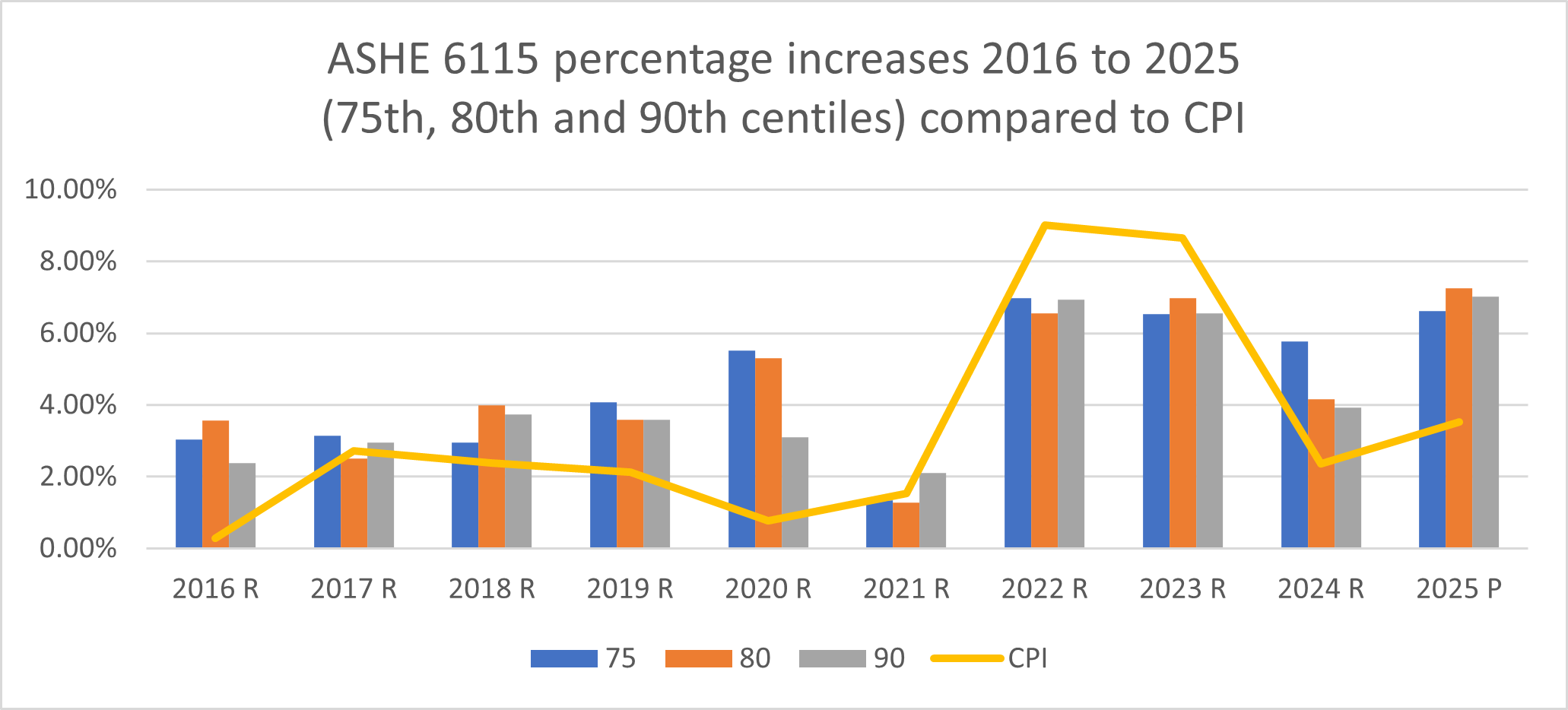ASHE figures for care workers
-
Insight Article 2025年10月30日 2025年10月30日
-
Casualty claims
-
保险和再保险
The Annual Survey of Hours and Earnings (ASHE) April 2025 provisional figures (“2025P”) have now been published together with the revised figures for April 2024 (“2024R”).
Since the 2010 reclassification, the ONS have continued to publish figures equivalent to ASHE 6115 (care assistants and home carers) in ASHE Table 26 to assist with the indexation of periodical payment orders for care costs.
The weekly and hourly earnings for carers compared to all employees are shown below with the National Living Wage effective from 1 April each year for context:
| Table | 2025P | 2024R | |
| £ | £ | ||
| Median weekly earnings for all full-time employees | 1.1a | 766.60 | 728.30 |
| Median weekly earnings for all full-time carers | 26.1a | 584.10 | 540.00 |
| Median hourly earnings for all full-time employees | 1.5a | 19.74 | 18.72 |
| Median hourly earnings for all full-time carers | 26.5a | 13.55 | 12.79 |
| Median hourly earnings for all employees | 1.5a | 17.96 | 17.09 |
| Median hourly earnings for all carers | 26.5a | 13.55 | 12.77 |
| National Living Wage effective from 1 April1 | 12.21 | 11.44 |
The full government release can be found here: Employee earnings in the UK - Office for National Statistics
The published Tables 26.5a from 2011 to 2025 can be found here: Earnings and hours worked, care workers: ASHE Table 26 - Office for National Statistics.
The overall increases are summarised below, alongside other inflation measures for comparison:
| % Change 2024R to 2025P |
% Change 2023R to 2024R |
% Change 2022R to 2023R |
|
| Median weekly earnings for all full-time employees | 5.3% | 6.0% | 7.0% |
| Median weekly earnings for all full-time carers | 8.2% | 8.3% | 9.4% |
| National Living Wage (NLW) | 6.7% | 9.8% | 9.7% |
| Retail Prices Index (RPI) | 4.5% | 3.3% | 11.4% |
| Consumer Prices Index (CPI) | 3.5% | 2.4% | 8.7% |
As in 2024, the latest figures show that full-time carers overall weekly earnings have increased more than full-time earnings in general with the gap widening slightly. Median weekly earnings rose by 5.3% to April 2025 with increases for all major occupational groups, the largest of which was “caring, leisure and other service occupations” which increased by 7.1%2 with the median weekly earnings for all carers increasing by 8.2%. Within that occupational group, the increase for all full-time carers is substantially more than inflation (CPI/RPI) and has moved above the increase in NLW for the first time.
Application to ASHE Linked PPOs
The figures for the most common percentiles in terms of Periodical Payment orders are shown below for the hourly earnings for all carers:
| Table 26.5a | 2023 Revised | 2024 Provisional | 2024 Revised | 2025 Provisional | % Change 2024R to 2025P |
% Change 2023R to 2024R |
| SOC 2020 | SOC 2020 | SOC 2020 | SOC 2020 | |||
| 90th centile | £16.63 | £17.27 | £17.24 | £18.45 | 7.02% | 3.67% |
| 80th centile | £14.44 | £15.03 | £15.03 | £16.12 | 7.25% | 4.09% |
| 75th centile | £13.72 | £14.50 | £14.50 | £15.46 | 6.62% | 5.69% |
Unlike last year, when the 80th and 90th centiles had lower percentage increases than the 75th centile, the increases across the three top centiles to April 2025 are all around 7%.
The chart below illustrates the movement in the annual percentage increases in ASHE 6115 75th, 80th and 90th centiles hourly rates3 alongside the corresponding percentage increases for inflation (CPI).

Following three years of below CPI increases, and two years of high inflation, the 2024 and 2025 increases are above CPI inflation which is currently almost double the Bank of England target of 2.0%. The extent of the increases in 2025 are perhaps unexpected given the fall in CPI but may be a response to the difficulties attracting and retaining staff in addition to the above inflation increase in the NLW.
The Low Pay Commission anticipates a 4.1% increase to the NLW in April 20264 to £12.71. It is therefore possible that the 2026 ASHE figures (due to be published in or around October 2026) will show a lower percentage increase than in recent years as carers are generally paid at, or just above, the NLW.
Providers in the care sector can however find it hard to maintain service standards in the face of workforce shortages among other wider issues. Those in the care sector are often paid less than equivalent roles in the NHS with the report “Investigating Variation in Pay in Adult Social Care” published in October 2024 identifying a 35.6% pay gap between the average pay of a social care worker and an equivalent role in the NHS.
Pay is seen as one of the key factors to improve staff recruitment and retention in the care sector with options such as replacing the NLW with the Real Living Wage5 and aligning salaries with NHS counterparts suggested by some as crucial first steps6. Should these reforms be introduced the resulting increases in care hourly rates would be substantial, it is however unlikely in the short term at least that such increases could be funded by care providers.
If there are any queries in relation to the contents of this article then please contact Clyde & Co’s PPO Unit (PPO@clydeco.com). The PPO Unit are also available for any queries in relation to periodical payments including administering the annual payments, drafting orders and advising in relation to case specific issues.
1. National Minimum Wage and National Living Wage rates - GOV.UK
2. Source: Office for National Statistics (ONS), released 23 October 2025, ONS website, statistical bulletin here.
3. Although there is effectively a ‘break’ in the data at each SOC reclassification which means direct comparison across SOC 2000, SOC 2010 and SOC 2020 may not be possible, we have used the data to illustrate general trends.
4. Source: The Low Pay Commission projections published on 5 August 2025 National Living Wage estimate update - GOV.UK
5. A voluntary wage rate calculated based on the cost of Living which will be £13.45 an hour outside London for 2025/26 and £14.80 in London
6. The Social Care Workforce Crisis in 2025: Challenges, Failures, and a Path Forward | Quality Care Group News
结束

